Occupational environment monitoring of a plastic pellet manufacturing factory
99,000 ₫
Note: The above price is calculated for one sample, and the price may fluctuate depending on the area of the environment to be monitored and market movements. For more accurate pricing support, please refer to the price list or contact our consulting staff directly.
Monitoring the environment of a plastic pellet manufacturing factory is a session of collecting, analyzing, and evaluating factors at the workplace that may harm workers health.
Table of Contents
Toggle1. Overview of Plastic Pellet Manufacturing Factories
a. What is a plastic pellet manufacturing factory?
Factory for plastic pellet manufacturing is a facility specialized in producing plastic pellets, also known as small-diameter plastic granules. These pellets are commonly used to produce other plastic products such as bags, bottles, pipes, sheets, boxes, computer cases, phone cases, and many other plastic items. The production process includes processing raw plastic materials into pellets, removing impurities, and creating highly uniform and pure plastic pellets.

b. Production stages in plastic pellet manufacturing factories
The production stages in plastic pellet manufacturing factories include:
- Raw material preparation: Materials such as plastic, fillers, pigments, and additives are selected, quality-checked, and fed into the mixing system to prepare for production.
- Mixing and dissolving: Raw materials are mixed and dissolved in mixing tanks to ensure product uniformity and purity.
- Plastic extrusion: The mixed materials are heated and extruded through molds to form plastic pellets.
- Separation and cleaning: After extrusion, the pellets are separated and transferred to separation tanks to remove remaining impurities.
- Drying: Plastic pellets are dried to remove moisture and increase product durability.
- Packaging: Plastic pellets are packaged in suitable containers according to customer requirements.

c. Machinery used in plastic pellet manufacturing factories
Common machinery used in plastic pellet manufacturing factories includes:
- Grinders: Used to grind plastic materials into pellets.
- Mixers: Used to mix plastic pellets with additives and colors to create pellets with desired properties and colors.
- Plastic pellet extruders: Used to press plastic pellets under high pressure to achieve the desired size and shape.
- Separators: Used to separate pellets from unwanted additives and colors.
- Dryers: Used to dry plastic pellets after mixing and extrusion.
- Packaging machines: Used to package plastic pellets for transport and storage.
- Quality control machines: Used to check the uniformity of color and size of pellets before packaging and shipping.

d. Occupational diseases that may occur among workers in plastic pellet manufacturing factories
Workers in plastic pellet manufacturing factories may be exposed to various occupational diseases, such as:
- Respiratory diseases: Exposure to plastic pellets, dust, and toxic fumes during production may cause difficulty breathing, coughing, asthma, bronchitis, and pneumonia.
- Skin diseases: Direct contact with chemicals during production can cause skin irritation, eczema, dermatitis, and burns.
- Eye diseases: Exposure to pellets, dust, and chemicals may result in eye pain, blurred vision, swelling, conjunctivitis, cataracts, or blindness.
- Hearing disorders: Continuous exposure to factory noise may lead to electric shock incidents, hearing loss, and other ear-related issues.
- Musculoskeletal disorders: Activities such as lifting, pulling, and transporting bags of plastic pellets can cause back, shoulder, and neck pain, as well as other musculoskeletal problems.
- Mental health conditions: Job pressure, exposure to toxic substances, and other workplace factors may lead to insomnia, depression, anxiety, and other psychological issues.
These occupational diseases can affect workers’ health and safety, reduce labor productivity, and cause long-term health damage.

e. Common types of plastic pellets on the market
Currently, many types of plastic pellets are produced and consumed, including:
- Polyethylene (PE) pellets: The most common type, used for plastic bags, bottles, packaging materials, and many other applications.
- Polypropylene (PP) pellets: Heat-resistant and water-resistant, used for containers, roofing sheets, and packaging materials.
- Polystyrene (PS) pellets: Hard and brittle, used for toys, cups, and insulation sheets.
- Polyvinyl chloride (PVC) pellets: Flexible and heat-resistant, used for pipes, insulation sheets, and packaging materials.
- Acrylonitrile Butadiene Styrene (ABS) pellets: Impact-resistant and durable, used for toys, automotive parts, and household appliances.
- Polycarbonate (PC) pellets: Highly impact-resistant, durable, and heat-resistant, used for safety glass, masks, and packaging materials.
- Polyethylene terephthalate (PET) pellets: Flexible, elastic, and heat-resistant, used for beverage bottles, textile fibers, and packaging products.
- Polymethyl methacrylate (PMMA) pellets: Transparent, hard, and elastic, used for glass, computer cases, and advertising products.

2. Overview of occupational environment monitoring services
a. What is occupational environment monitoring in plastic pellet factories?
Occupational environment monitoring (or workplace environment measurement) in plastic pellet manufacturing factories involves collecting, evaluating, and analyzing measurements of workplace environmental factors in the factory. The goal is to implement timely measures to reduce environmental impacts on workers’ health and prevent occupational diseases. Occupational environment monitoring is mandatory for plastic pellet manufacturing factories.
This monitoring plays a crucial role in protecting and enhancing workers’ health, as workers are the main resource directly generating profits for the enterprise. Employees regularly exposed to hazards beyond permissible limits are at risk of health issues and occupational diseases.
REGISTER FOR OCCUPATIONAL ENVIRONMENT MONITORING SERVICE
b. Nam Viet’s occupational environment monitoring program
Nam Viet’s program is developed by monitoring engineers specializing in occupational safety and environmental protection. Aiming to ensure worker health and safety, it uses modern measurement methods to monitor air, water, microclimate, physical, and dust factors in the workplace. This program is essential for maintaining a safe working environment and protecting workers’ health.
Additionally, Nam Viet’s monitoring program plays a key role in researching and developing new solutions to improve workplace environmental quality. With the dedication and professionalism of monitoring experts, Nam Viet’s exclusive program represents a breakthrough in occupational safety and environmental management in Vietnam.

c. Standardization in occupational environment measurement procedures
Standardization in Nam Viet’s procedures is crucial to ensure measurement quality. To guarantee accuracy and reliability, the program follows standards recognized by the Ho Chi Minh City Department of Health. This ensures collected data are reliable for evaluating the workplace environment and making decisions to improve it for worker health protection.
Standardized procedures ensure that measurements are conducted by highly qualified monitoring specialists with years of experience, allowing managers and experts to trust results from An Toan Nam Viet and make accurate, valuable decisions for worker health and environmental protection.
By applying standardization, Nam Viet demonstrates its commitment to ensuring a safe work environment and protecting worker health while contributing to the development and improvement of occupational safety and environmental management in Vietnam.
d. Plastic pellet factory monitoring reports
Occupational environment monitoring results are prepared according to Form No. 04, Appendix III of Decree 44/2016/ND-CP and prepared in two copies: one sent to the contracting enterprise, and one retained by the monitoring organization.
Retention of monitoring results is indefinite, as required by law.

e. Frequency of occupational environment monitoring as required by law
According to Clause 2 of Article 18 of Law on Occupational Safety and Hygiene 84/2015/QH13, employers must organize occupational environment monitoring to assess harmful factors at least once a year.
f. Deadline for submitting occupational environment monitoring reports as required by law
The submission deadline is before December 31 each year. Enterprises operating production facilities must submit occupational environment monitoring reports to the local Department of Health where their headquarters and workers are located.
When there are changes in production technology, processes, or when renovating/upgrading workplaces that may introduce new hazards affecting worker health, enterprises must update occupational hygiene records regarding harmful factors requiring monitoring.
g. Regulations on penalties for violations of occupational environment monitoring by employers
According to Article 27 of Decree No. 12/2022/ND-CP dated January 17, 2022, regulating administrative penalties in labor, social insurance, and Vietnamese workers working abroad under contracts:
- Clause 2: A fine of VND 2,000,000 – 5,000,000 for employers who fail to publicly disclose to employees at the monitored workplace and site being inspected, evaluated, and managed regarding hazardous factors immediately after receiving monitoring results.
- Clause 3: A fine of VND 20,000,000 – 40,000,000 for employers who fail to conduct occupational environment monitoring to control hazards affecting worker health as required by law.
- Clause 4: A fine of VND 40,000,000 – 60,000,000 for employers who collude with monitoring organizations to commit fraud in occupational environment monitoring activities but without criminal liability.
3. Harmful Environmental Factors for Workers in Plastic Pellet Manufacturing Factories
Harmful environmental factors for workers in plastic pellet manufacturing factories include:
- Dust and toxic fumes: During production, plastic pellets may generate dust and toxic fumes such as formaldehyde, styrene, acrylonitrile, polyvinyl chloride (PVC), and polyethylene terephthalate (PET), which pose health risks to workers.
- Temperature and humidity: The working environment in plastic pellet factories is often very dry and hot, which can cause fatigue, dehydration, and reduced work performance.
- Noise: Machinery in plastic pellet factories often operates continuously and produces high levels of noise, which may harm workers’ hearing.
- Lighting: Light sources in plastic pellet factories can also negatively affect workers’ vision.
- Allergenic materials: Some workers may be allergic to materials such as rubber, latex, and plastics, which can cause serious health issues.
- Other factors: In addition, other factors such as toxic gases, static electricity, and fire/explosion risks are potential hazards to workers’ health in plastic pellet factories.
REGISTER FOR OCCUPATIONAL ENVIRONMENT MONITORING SERVICE
4. Measures to Improve the Working Environment in Plastic Pellet Manufacturing Factories
To improve the working environment in plastic pellet manufacturing factories, the following measures can be implemented:
- Ensure proper ventilation and air circulation: Production activities in plastic pellet factories often generate dust and toxic gases. To minimize their impact on workers’ health, the factory must ensure good ventilation and air circulation.
- Use wastewater and exhaust treatment systems: Plastic pellet factories often generate a large volume of wastewater and toxic exhaust. To reduce their impact on the environment and workers’ health, factories need to equip appropriate treatment systems.
- Ensure safety during production: Workers in plastic pellet factories need to be trained and equipped with personal protective equipment to ensure safety during operations.
- Control temperature and humidity in the factory: Temperature and humidity are critical factors for plastic pellet production. Controlling these factors improves the working environment and ensures product quality.
- Maintain factory hygiene: Plastic pellet factories must maintain cleanliness during production to ensure a safe and clean working environment for employees.
- Use modern equipment and technology: Implementing advanced equipment and technology helps minimize the environmental and health impacts of plastic pellet production.
- Regularly conduct occupational environment monitoring in factories, collect and analyze harmful factors for workers, and adjust measures to reduce risks to prevent occupational diseases.
5. Benefits of Periodic Monitoring in Plastic Pellet Manufacturing Factories
An Toan Nam Viet provides excellent benefits for enterprises using occupational environment monitoring services according to Decree 44/2016/ND – CP on managing and controlling harmful factors in the working environment affecting workers.
- Enterprises can proactively control harmful factors in the factory.
- Receive consultation and recommendations for measures to reduce harmful factors and improve workplace quality.
- Indirectly protect human resources, the main factor in business development.
- Reduce the impact of occupational diseases on health, thereby minimizing future treatment costs.
- Improve workers’ health, leading to consistent product quality and output.
- Ensure compliance with occupational safety laws, avoiding legal risks.
- Create credibility and professionalism in all aspects, enhancing the enterprise’s brand value.
Nam Viet’s environmental monitoring service is a solution to reduce occupational disease risks, contributing to a clean and high-quality working environment.

6. Nationwide Occupational Environment Monitoring Center
Occupational Environment Monitoring Center of Nam Viet is a professional unit monitoring and measuring occupational environment quality across all provinces in Vietnam. With an experienced team of monitoring specialists, the center uses modern measuring equipment to ensure accuracy and reliability.
In addition to monitoring services, the center assists clients in planning, handling, and following up on occupational environment issues. Following the principle “customer-centered,” the center prioritizes customer satisfaction, meets all client needs, and commits to providing the best solutions for businesses.
REGISTER FOR OCCUPATIONAL ENVIRONMENT MONITORING SERVICE
With investment in technology, equipment, and personnel, Nam Viet’s monitoring center has become a reputable unit in occupational environment monitoring in Ho Chi Minh City with the following objectives:
- We always value brand reputation and service quality.
- We provide clients with the best and most suitable solutions.
- Along with a team of experienced Masters and Engineers dedicated to environmental protection and benefiting enterprises.
- By choosing Nam Viet Environmental Monitoring, your company will receive professional service from experts in monitoring, along with the best cost incentives.
The occupational environment monitoring process at Nam Viet includes the following steps:
- Before monitoring, we ensure all machinery and equipment are calibrated and compliant with legal regulations.
- Conduct the full monitoring procedures as committed to the Department of Health.
- Report monitoring results honestly to the employer.
- If results indicate unsafe conditions, Nam Viet will assist with solutions, and the factory will implement:
- Measures to improve working conditions, minimize harmful factor impacts, and prevent occupational diseases.
- Health checks for early detection of occupational and work-related diseases for workers in unsafe areas.
- Material compensation for workers according to labor law regulations.

7. Occupational Environment Monitoring Price List
To help enterprises conduct occupational environment monitoring professionally and effectively, Nam Viet provides clients with a price list for occupational environment monitoring services that is both high-quality and reasonably priced.
- Our price list provides detailed information on the cost of monitoring services, including expenses for transportation, measurement, analysis, and reporting. Clients can fully trust the accuracy and reliability of our reports.
- We commit to offering competitive and reasonable prices and are always ready to consult and answer all questions about monitoring services quickly and professionally.
- With Nam Viet’s price list, clients can easily choose service packages that fit their needs. We guarantee maximum satisfaction with professional service quality.
No comments yet


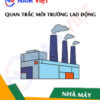
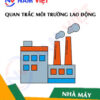


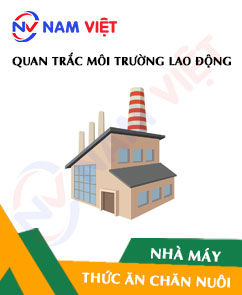

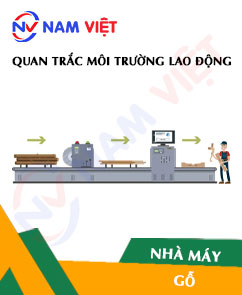
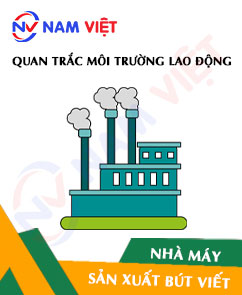
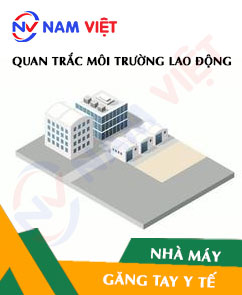

Review Occupational environment monitoring of a plastic pellet manufacturing factory
There are no reviews yet.